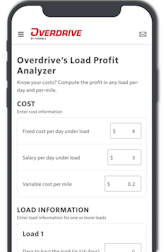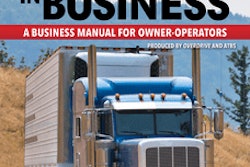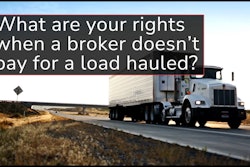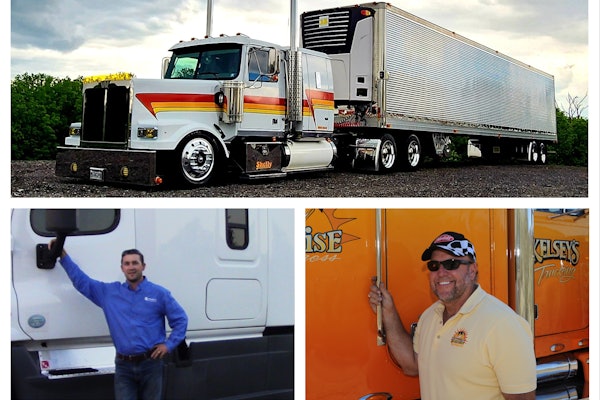Two upsides to getting your own carrier authority are the potential to make more money than a leased owner and the almost complete freedom associated with how you run the business. This sounds wonderful in theory, but with freedom come risk and responsibility.
Many owner-operators decline to pursue getting their authority because they realize they are unprepared for that level of responsibility. Or in some cases, industry conditions are not favorable.
Preparation, though, still is far more important than shifts in the economy.
In a hot freight market, ambitious truckers see career-move risks tilting in their favor. Company drivers consider opportunities as owner-operators, and leased operators think of striking out under their own authority.
Independents equipped to survive in any market will have adopted tools that enhance their awareness of key market metrics. These include regional load-to-truck and inbound-to-outbound load-post ratios, as well as rate fluctuations in specific lanes. They also will have built relationships with a few key players, whether it’s shippers, brokers, factors, or, if they have more than one truck, reliable drivers.
Those who learn as they prosper also will be more likely to stay profitable when the gravy train has pulled out. The preparation starts with getting freight. You’ll have to locate your own customers or work through load boards and brokers.

[Related: Roads through the dark clouds of a very tough market: Owner-operator limitations, possibilities]
Finding your own customers
Soliciting freight from shippers can be a daunting task for an individual, but in normal times it results in the highest net income because there is no middleman to take a cut. The post-COVID market boom in 2020 and 2021 enticed more drivers to strike out on their own to become owner-operators, many with authority, and allowed already existing owner-operator businesses the revenues and opportunity to bring on more trucks, accounting for much of the growth in trucking over the period. When the market turned in shippers’ favor, though, beginning in 2022, many operations relying heavily on the spot market and brokers just weren’t in a position to weather the storm.
By contrast, small carriers with direct customers, whether with long-term rate contracts on paper or working under contract on a handshake agreement, have been able to hang on and/or prosper as long as demand for their customers’ product has remained at least somewhat stable. As of the beginning of 2025, the market had begun to turn back toward truckers, though most watchers still see it in favor of shippers when it comes to demand and pricing.
Yet for any owner-operator, having freight you can consistently rely on to keep your truck or trucks profitable can be the difference between staying in business -- or failing spectacularly.
There are several ways to find small local shippers. You can use business directories online or attend local business functions such as Chamber of Commerce events. A simple way to start: Drive around industrial parks in your area and take notes.
List 25 to 50 potential customers, then schedule time off to contact the shipping managers unless you have a spouse or other partner who can handle this. Be ready to hear no many times. If you generate just one customer, consider it a success.
[Related: 'The spot market is not where you need to live': On building business with motor carrier authority]
As a one-man show, you may find this task awfully time-consuming and difficult. If you’ve never worked in sales, prepare yourself. There are hundreds of great audiobooks on sales and negotiation. Listen to some while working on your plan.
In any bid to secure a contract with a shipper, make sure you can answer this question: Why you? Why should any particular shipper entrust its freight to you? Setting yourself apart from the crowd, however you do it, will help you find customers that can last throughout your career.
Some ways to build a customer base include having special equipment, running a part of the country where many others don’t like to go, or finding your way into a niche market such as hauling cattle or cars. (Find numerous features detailing a variety of trucking niches in Overdrive's "Niche Hauls" archive.)
[Related: Finding your niche haul: The tradeoffs and triumphs in freight specialization]
It’s equally important to vet new customers to minimize the risk of nonpayment. Some major load boards and factors closely track payment histories and provide this information to their clients.
Getting help: Brokers, dispatchers, third-party sales
If personal solicitation sounds too overwhelming, consider other options:
- Hire a freight broker to work as your direct sales agent.
- Find a business partner with experience in freight sales. If you choose to follow this path, you may need your broker authority or other drivers employed under you in order to move enough freight to support both partners.
- Use an independent dispatch service that acts as a bridge between carriers and brokered spot market freight. Instead of dealing directly with brokers, truckers pay for negotiating prowess and access to relationships any good full-time independent dispatcher has built with brokers. In ideal situations the additional fees siphoned off to the dispatch service are more than made up for by higher rates. You may spend $50 per load, which for a week might be $150 total on $7,000-$8,000 in revenue, or around 2% of revenue, though some independent dispatchers charge as much as 10% per load. On the other hand, scouring load boards and building relationships with brokers and freight agents, as the best independent dispatchers do well, ought to be achievable for an owner-operator. Making phone calls and studying the markets can allow you to pocket those fees.
Whether or not you decide to acquire your own customers, make a plan for working with brokers or using load boards to serve your freight needs when your shippers are slow. Or if you’re focusing on one or more brokers as your primary freight partner/customer, look for brokers who will meet your profit needs regularly. Don’t make the mistake of looking randomly for freight every time you need to load. In the beginning, many owner-operators focus on good back-and-forth lanes or areas with one point being your home -- or use a triangular strategy to find the best rates.
Consider fuel prices in all those lanes, weather, traffic, road conditions and, of course, freight rates and availability. Research load boards daily to see what is available in your preferred areas. You’ll learn types of freight, average rates and which brokers have the freight.
While working with brokers can help you, be wary of nonpayment on loads from those with whom you don’t have a solid, longer-term relationship. Just one or two instances of not getting paid could bring on a cascade of financial troubles. Always vet an unfamiliar broker’s credit with readily available services -- you can find several via Overdrive’s “Broker Reforms” series and elsewhere in more recent business coverage, likewise here in the Independence and Growth section of the Partners in Business playbook.
Among those offering credit checking services are reputable factoring companies. The broker checks are often available through factors’ mobile apps and/or online portals. If a factoring company won’t factor a broker’s load, they’re worried about getting paid themselves. If they’re worried, you should be, too.
Once satisfied with an area or lanes, contact brokers who control freight there, and explain what you have to offer. Your goal is to create a strong relationship and provide outstanding customer service.
[Related: In a tough spot market, strong relationships with those who feed you will pay off]
According to research from load board Truckstop, nearly 80% of owner-operators indicate they just don’t like to negotiate rates with a broker. That may be the case, but it’s a fact that a better understanding of how to communicate with brokers and speak their language can pay off for carriers who engage in negotiations.
An owner-operator armed with market knowledge backed up by data and a clear set of expectations when it comes to freight rates is liable to be successful achieving those rates more often than not.
How a carrier starts a relationship with a broker from the very first conversation about any load is one of the most important elements in laying the groundwork for that and future negotiations. Generally speaking, the more information you’re ready with as the conversations start, the more a broker can help you get the loads you need to stay profitable. Providing specific information about your equipment, your exact location and more will help in both the negotiation and in building the relationship.
[Related: Beat the 'winner's curse' of auction-type negotiations for better freight rates]
Diving deeper into more refined tools that load boards offer to subscribers, owners can find market outbound averages, too, for loads they’re looking at, and demand metrics like posted load-to-posted truck ratios for any given area.
Always be sure to double-check mileage quoted from a broker or load board. Sometimes the mileage you see is from city-to-city rather than address-to-address. Additionally, be aware of co-brokered loads, with more than one broker party to the freight contract, which add more middlemen to the equation.
In 2024, Overdrive hosted an online panel discussion with working owners and small fleets about ways to build business for trucking's down cycles, instructive for anyone considering doing business with motor carrier authority. Find parts 1 and 2, consecutively, of the Overdrive Radio podcast versions of the panel discussion that follow:
Read next: What are your rights, recourse options when a broker doesn’t pay?











